At DSEI we got to take a look at the Future Soldier Vision, the UK Ministry of Defence’s Defence Science and Technology Laboratory’s conceptual vision of what the Soldier will look like in 2024.
Head Sub-System
Soldiers will have enhanced multi-spectral sensors enabled by modular integration, to provide mission-tailored systems at significantly reduced weight. Sensors will be capable of fusing their feeds and being shared between soldiers, providing collaborative targeting and engagement capabilities. For example this network capability will enable small unmanned aircraft systems to provide commanders with enhanced battlefield surveillance and target acquisition.
– Integrated sensors
– Integrated power supply
– Hearing protection system
– Respirator/mandible connector
Torso Sub-System
Soldiers will be able to tailor their protection according to the mission requirement, balancing protection with agility to provide optimal survivability. Future systems will consist of tiered, modular protection providing enhanced capability, without increasing weight. Design and integration with other elements of the soldier system will ensure legacy and future compatibility.
– Hard body armor
– Ratchet adjusting system
– Integrated connectors
– Asymmetric design
– Quick release cord
– Flexible shoulder pads
– Integrated power supply
– Integrated load carrying
Wearable Communications Concept
The advent of a body sensor network will provide real-time reporting of soldier health. Sensors embedded in the helmet, clothing, and smartwatch will monitor physical health and performance. Wirelessly linked to the soldier processing system, the availability of this data will allow the commander to make informed decisions during combat. If the soldier is seriously injured, information will enable medics to act faster during the ‘golden hour’ following trauma.
– Biometric data
– Push to talk
– Screen graphic
– Screen protection
– Accessing functionality
Smart Glasses Concept
The presentation of real-time data will enable greater clarity and quality of information throughout the operational system.
– Heads up display with augmented reality presentation
– Bone conducting headphones
– Integrated camera
– Power and data connection
Personal Role Computer Concept
Commanders and troops will be provided with information across a set of connected devices covering visual, acoustic, and tactile interfaces to access voice, data, video, and historical information. The information architecture will ensure commonality of data, with each device determining the appropriate means of presentation. Navigation system will incorporate simultaneous localization and mapping technology and be capable of operating in a global positioning system-denied environment.
– Screen protection
– Screen graphic
– USB protection
– Push to talk
– Camera
– Assembly
Weapon Concept
Individual weapons will have improved ergonomics, with effects spanning combinations of lethal and non-lethal capabilities. The ability to seamlessly provide targeting information between soldiers and their units will allow collaborative engagement to become commonplace. The increase in timeliness and accuracy of multiple weapon systems will result in a more effective fighting force.
– Enhanced stock design
– Digital optical weapon sights
– Adjustable down grip
– Adjustable pistol grip
Although not specifically mentioned in the other technology areas, they also displayed this conceptual boot.
Much of the development work was accomplished by Kinneir Dufort. They also had a display of the system in their booth.
www.gov.uk/government/organisations/defence-science-and-technology-laboratory
Tags: DSTL


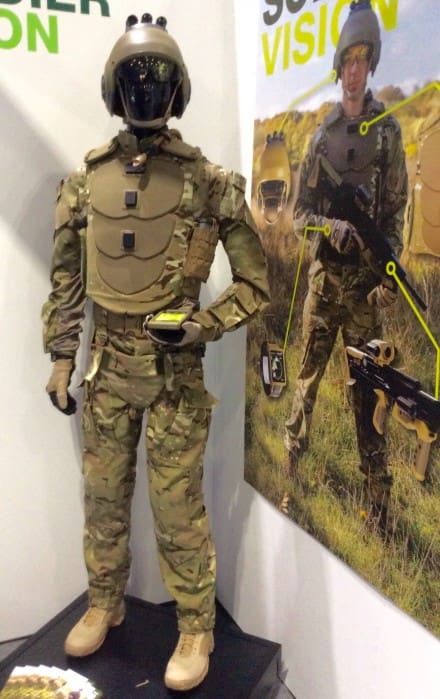
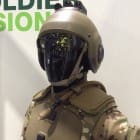
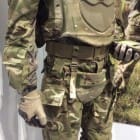

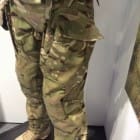
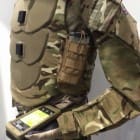
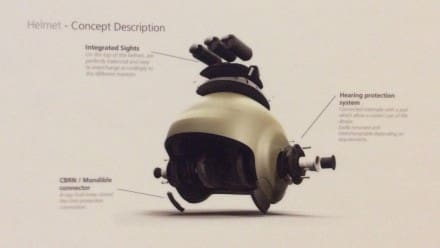
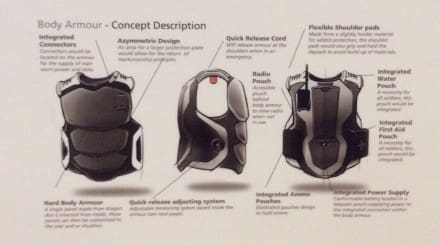
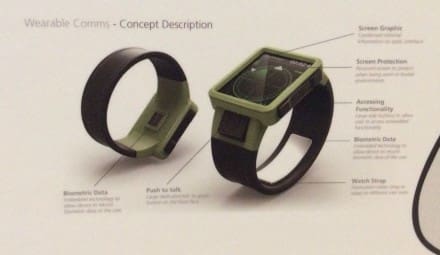
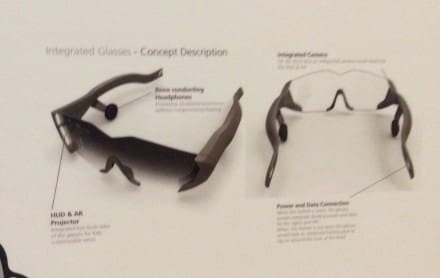

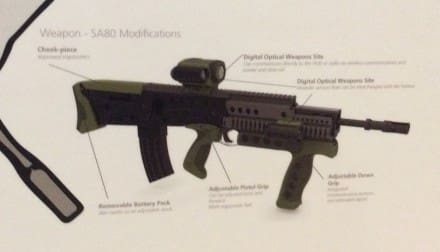

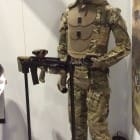



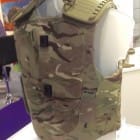

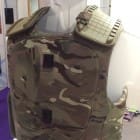

I’m reminded of this – http://cdn.defenseone.com/defenseone/interstitial.html?v=2.1.1&rf=http%3A%2F%2Fwww.defenseone.com%2Ftechnology%2F2015%2F09%2Fdutch-air-force-chief-slams-us-army-helicopter-future%2F120980%2F%3Foref%3Dd-dontmiss
Lt. Gen. Alexander Schnitger gets the notion right:
“When I look at the [Future] designs, I see today’s technology being incrementally improved toward the future. What I would like to see is a disruptive vision of the vertical-lift capabilities that is ready for any operation in 2040. Instead of extrapolating today into the future, I’d like to start with the future and then decide how to get there.”
Isn’t that how we ended up with the F-35 debacle?
Exactly! Cutting edge concepts that depart from known technology means high risk of failure. Everyone wants something completely new, but nobody accepts when it doesn’t work out like they planned.
A better example than the F35 or the Ford class carrier about weapons programs promising timely delivery of technology is Future Combat Systems.
It featured vehicles with yet to be created armor, yet to be created armor protective systems (the Israelis still haven’t figured how to protect people outside the vehicle), software that fused every system from intelligence to communication (over a decade later and we are still screwing with that for the F35), autonomous drones and robots that still don’t exist and sensors that would give us a 90% enemy intel picture (wouldn’t that be handy).
Well, the original thrust of the JSF was economy as one of the pillars of the program, in being able to purchase thousands of one kind of aircraft that would supposedly do all things ‘well’ as opposed to running a dozen different aircraft across branches that each need their own training, mechanical upkeep, and have different lifecycles.
The UK was the original sign on partner for the aspiration to access a generation 5 fighter that would be interoperable with coalition efforts, and then it got opened up to the rest of the world for purchase options and part production.
To get back to your question – no – the JSF was never meant to be the disruptive aircraft of the future. The JSF was meant to be the do-all, less capable, less expensive aircraft compared to the bigger brother F-22 as air superiority fighter, where Lockheed won out against Boeing’s offering.
It started with good intentions for a superior (gen 5 as opposed to 4.5 with Super Hornets and Eurofighters), interoperable, AND economical (through bulk buying across national services) aircraft that also furthered international relations – but damn those aspirations have melted away.
I recommend anyone take a peek at the GAO report. I think it’s about five years old now. The whole saga is terrifying.
A big reason why ended up with the mess that’s the F-35 is called concurrency. The idea was that while many of the systems and tech that would go into the F-35 hadn’t been created yet they’d develop it as they went along with building and designing the F-35. That’s why they’re having so many problems with the program, it’s because it’s really more than just an aircraft development program, it’s also an avionics, mechanical systems, weapons, etc. program happening along side the plane program. The sad thing is, the DoD hasn’t learned their lesson with the F-35 and are practicing concurrency with the Ford class carriers to the point that the Navy wasn’t sure about conducting a shakedown cruise with the Ford and delaying it and doing a shakedown with the second carrier in the class. Fortunately, I believe the SecDef is telling the Navy that it’s a much better idea to do it with the Ford so they only have to fix one ship since the lessons learned would be applied to the second, and all follow on ships, before they start building it.
Glad to learn, RB. I pay more attention to the things with wings more than ships, unless they’re icebreakers/arctic related.
Thanks for the insight.
I still have a 2000 issue of Popular Science where they had a vision of “Soldier 2025.”
http://www.unzcloud.com/wp-content/uploads/2013/01/future-soldier1.jpg
15mm guided rocket pistols, exoskeletons, color shifting camo. Sadly, still aways off,
They still got 10 years to pull it off.
Uh, this stuff already exists. Won’t it be very much outdated by 2024?
It’ll fit in with the rest of our stuff then!
+1
Exactly. Our trouble is, we take too long to role stuff out for budgetary reasons. By the time the rear echelon nerds have got their hands on it, us infantry boys are crying out for something better as the tech is already 5-10 years ahead of us.
And for f-sake i wish they would stop breathing life into a dead horse with those sa80 concepts. That thing warrrants scrapping, it’s past it’s use by date. I have never used one that doesn’t rattle in two parts. Innacurate as hell.
Trials are already a go for a replacement, i shall sadly be done and dusted with the army by the time it’s fielded.
Welcome to the MOD. Yesterday’s technology tomorrow.
Looks like Spaceballs!
http://images.fandango.com/MDCsite/images/featured/201306/spaceballstopphoto.jpg
Spaceballs?
Exactly what I was thinking!
Surrounded by assholes!
Jon, OPT
But will it dispense Stimpaks and Med-X when you get hurt?
Dragonskin plates? Did they not get the memo from 2007?
That memo was pretty theater-specific and contract-protecting. Maybe in the future we won’t be in the desert OR protecting who gets what contract. LOLJK.
They lost NIJ cert not long after the very public hoopla about the ban, did they not? The army provided evidence and test results explaining their reasoning. If dragonskin is the bee’s knees, why doesn’t anybody anywhere use them in large numbers? Am I mistaken?
The idea behind Dragon Skin, a ceramic core surrounded by a polyethelene sleeve, can be purchased currently from a few industry-leading armor providers. The core can be other materials for various threats. They’re just big plates instead of a lot of little ones.
Huh. You learn something every day. Wasn’t their big selling point the scale mail armor?
I think their selling point was weight reduction, which is still achieved by PE/Traditional materials mix. Also of note was the ability to replace damaged sections and better mobility, but those are eternal struggles with armor.
Molecular armor may be whats next. The motorcycle armor industry is pretty much exploding with the stuff. It’s soft, flexible, lightweight, and temperature stable yet when you expose it to an impact it hardens up and spreads the impact across a greater surface area. I don’t think it would be too much farther of a reach to develop molecular armor for ballistic purposes.
Dragonskin promoted its armor as the most comfortable out there because of its small plates allowing mobility.
Repair was never a strong point because soldiers at the unit level couldn’t repair/install damaged plates. It had to go to a higher level of maintenance which begs the question, “what does the soldier use in the meantime?”
Dragonskin also stated its solution provided as much ballistic protection as the IBA. It does not. Rounds can skip between plates and individual plates do not defeat more than one round.
Dragonskin was a bit lighter and more comfortable as well as being more expensive. It couldn’t be repaired on the spot and didn’t stand up to the threat one expects front line troops to face. Sounds like a great solution for those that prize comfort over utility. Perfect for those that don’t get shot at much.
I was hoping you would comment on here. Thanks for cutting through bullshit once again, Majrod.
I thought a equivalent Large dragon skin weighed nearly twice what a IBA with equivalent protection did? I might be mistaken
I cant remember for the life of me where I saved that press release…
Dragonskin was another media journalist boinkfest feeding off the controversy from the iraq war. A bunch of armchair commandoes in the MSM that know nothing about body armor or anything military-related.
Just buy some damn M4s and call it good. The SA 80 sucks
You’ve used one then???
I haven’t but I did get to shoot a Steyr AUG before. Neat rifle but I prefer traditional setup rifles like the M4 and hope whatever eventually replaces the M16/M4 is as ergonomic and not bulpup.
The L85A2 doesnt ‘suck’ at all. But, spares run out in 2025 so I’m sure we will be looking at a replacement relatively soon. I note that mock up doesn’t have the tan coated TMH and upper.
wow in the future you only need one mag too
I feel like this effort so show us the “future” is a failed endeavor. There are three things that will revolutionize the combats soldier in the near future. Number 1: integrated night visions/thermal fusion face shield without the heavy goggle/battery system, combined with a simple HUD with IFF, Map, comms. Number 2: instead of rehashing SA80s into 1980s bullpups and calling it the future, we need to be focusing on hyper velocity “rail gun/gauss” with small, very fast pellets. Lots of shots, not a lot of weight. The tech is there but until very recently the energy storage capabilities to power the system has not been there. There has been revolutionary battery power storage break throughs in the past three years that when fleshed out will make this concept work. Number 3: Light weight “bullet proof” fabric. With the nano tech industry coming up now a days, the tough fabrics will be hopefully replacing the bulky and heavy armor.
Combine all three of the above concepts and you will have a soldier that is smarter and more aware. Able to outgun the enemy without being weighed down with heavy ammo. When combined with the specialized fabrics the soldier will be much more manuevable and agile while being protected from damage. All combined it will greatly increase the effectiveness of the soldier.
There’s another problem with current railgun tech, the sabots wear out the rails too quickly for comfort. Not to mention the weight, all those copper coils all along the rails would be freaking heavy. I could see it working with an exoskeleton though. You could probably plug it in to the exo’s power supply.
I agree with the current weigh issue. However, the upcoming super conducting nanotech will combat this. Add in the new battery tech and we are there.
What new battery tech?
The type of power storage necessary to run man portable rail guns or exoskeletons are still figments of imagination.
We’ll be getting close when we have laptop computers that can run a couple of days to a week on one charged battery (vs the hours we get today) or rail guns on wheeled vehicles instead of only being on ships that weigh thousands of tons.
If one thinks we are closer than that one simply doesn’t understand the actual combat requirements of these systems which must function for days (if not a week) away from infrastructure to be of combat utility.
We’re actually coming along nicely with battery tech. The rate at which research is pioneering the technology is going up exponentially. All it takes is one bright idea and it could revolutionize technology for a century. Hell, one guy had technology to run his internal combustion engine powered buggy off of nothing by tap water. Needless to say he wound up dead. But the tech is making a comeback now that his patents are expiring. SO don’t doubt what’s possible. 25 years ago we were still using the 16″ guns of the Missouri with a range of 20 miles, now we’re starting to see prototype rail guns on the decks of destroyers with a range of 250 miles. That’s a long way to come from in 25 years considering that those 16″ guns were commissioned almost 3/4 of a century ago.
Refreshing, if bizarre. Always interesting to see another view of the potential future, especially when displayed “in the flesh” as it were. I’d have so many questions for the designers on features that seem so odd to my particular sensibilities.
with this system while intriguing, the warfighter would also need a D8 truck battery strapped to his A$$… dragon skin was much more than political posturing… crazy heavy and NO V50 capability… but it does fondly remind me of another future warrior…
http://www.tactical-life.com/firearms/protective-products-futuristic-body-armor/
which was based on molded PE Armor …
What a stupid looking helmet !
Yea, that helmet looks like it belongs on an AFV type, or an aviator.
I’m still waiting for the day that Terran Space Marine armor becomes reality lol!
Why are they still hoping to have that POS SA80 in service by then? dear god. Talk about applying makeup and lipstick to a sow.